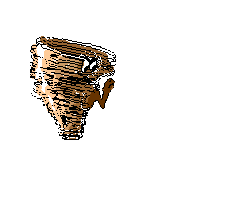
Tasmanian Devil (Sarcopilus harrisii)

Tasmanian Devil or Sarcophilus harrisii
is the largest surviving carnivore in Australia today. Of course, the first
thing we think of when someone mentions Tasmanian Devil, is the WB cartoon
character Taz. That little crazy, black colored animal cannot be mistaken
with any other marsupial.
Devils are widespread in Tasmania from the coast
to the mountains, from cold wet, to warm and dry areas. They live in coastal
heath, open dry rain forest. In fact, they live almost anywhere they can
hide and find shelter by day, and find food at night. Since they were annoying
little animals, the citizens of the Hobart Town, and were soon forced to
move to remote locations. In 1830 the Van Diemanís Land Co. introduced
a bounty scheme to remove the devils, as well as Tasmanian Tigers and wild
dogs, from their north-west properties. For over a century they were trapped
and poisoned and became very rare. They were definitely heading toward
extinction. Only after June 1941, the Tasmanian Devil was finally protected
by law. Its population started to gradually increase. Today, the Tasmanian
devil is chosen as the symbol of the Tasmanian National Parks and Wildlife
Service.
So how does Tasmanian Devil really look like?
Is he really a devil, and does he really spin fast like he does in cartoons?
The devil is usually black with white flashes on the rump and chest. Built
solid and strong, the devil possesses enormous crushing power in its jaws,
which allows him to crunch any meal, bones, flesh, fur and feathers, as
well as dead and dying animals, kangaroo, sheep, cattle, and horses. Devils
have jaws of biting power as strong as a dog about 4 times their weight.
It varies in size, depending on habitat. Males are usually bigger than
females. Their bodies are from 20 to 31 inches long and their tails are
from 9 to 12 inches. Males weigh from 15 to 26 pounds and females from
9 to 15 pounds. So far, no one has reported that the devil spins.
Tasmanian Devil also makes a variety of ferocious
noises, from harsh coughs and snarls to high pitch screeches. A sharp sneeze
is used as a challenge to other devils, and frequently comes before a fight.
As far as their other senses, their hearing is excellent, and proved the
be the dominant one. Their sense of smell is good as well. Like most nocturnal
animals their sight seems to be oriented heavily on black and white vision,
and black and white vision is mainly designed to detect movement. So for
an example, if something moves, Devils are more likely to detect it whereas
if it is still, they are unlikely to see it clearly.
They seem to have earned their name from Europeans.
It is easy to imagine the unearthly screams, coughs and growls coming from
devils scavenging, coming from behind someone's hut. The person living
there comes to investigate this strange noise and while holding an old
kerosene lamp sees these black and white animals with red ears, pink mouths
and big wide teeth. Who would not be frightened after all? No one really
knew anything about them except that they were scaring the hell out of
people. Aboriginals had several names for them. One was "tardiba" which
does not have a meaning in English language equivalent to the word "devil".
Most likely, aboriginals had a more rational and normal relationship with
the animal.
During the day it usually hides in a cave, or
dense bush. It is a nocturnal animal. Devil searches a great deal of area
for food (about 10 miles in radius). It usually wanders slowly with a characteristic
pace but when needed it can gallop quickly with both back feet together.
Young devils are more alert however and can climb trees. The famous
gaze or yawn of the devil that looks so threatening, can be misleading.
This look is performed more from fear and uncertainty than from aggression.
Devils produce a strong odor while under stress, but when they are
calm and relaxed, they are not stinking.
Devils usually mate in March, and the young are
born in April. Gestation is 21 days. More young are born than can be accommodated
in the mother's backward opening pouch, which has four sections. Although,
the average surviving rate among young ones is two to three. Each young,
is carried in the pouch for about four months. After this time the young
start venturing out of the pouch and are then left in a simple nest, often
a hollow log. Young devils are leaving their mother after that, and live
by themselves in the bushes by late December. They start breeding at the
end of their second year.Devils live about seven to eight years.
Tasmanian Devils are a pride of Tasmanian wildlife
in zoos and wildlife parks. They also have a fundamental role in our ecology,
and nature's auditors. Sick animals, slow animals, diseased animals, dead
animals are all eaten by devils. Lucky for us, they have not yet obtained
a taste for humans.
Works Cited
http://www.caddishatch.com
http://www.tased.edu.au
http://www.duit.hm.uwa.edu.au
http://www.britannica.com
Cool Taz links
Looney
cartoons
Melissa's
Tazmanian Devil page
Earthquest2000
- Tasmania